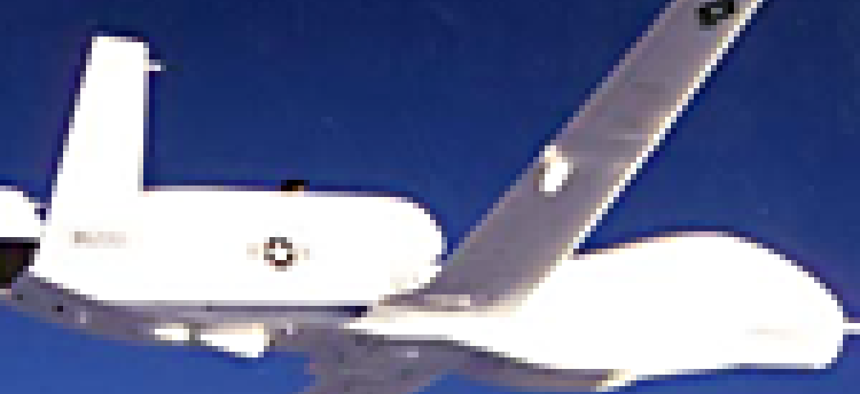
Pentagon plan calls for smarter, networked drones across air, sea and land
Despite a budget crunch, DOD wants to add autonomy and layers of integration to a growing unmanned force over the next 25 years.
The Pentagon has a vision for developing an integrated, networked force of unmanned vehicles — aerial, ground and seagoing, large and small — over the next 25 years, even if those plans have to go forward under reduced budgets.
The Defense Department’s recently released Unmanned Systems Integrated Roadmap describes a “vision and strategy for the continued development, production, test, training, operation, and sustainment of unmanned systems technology across DOD,” while acknowledging that budgets for unmanned systems will likely fall over the next five years. The administration’s 2014 budget released to Congress shows a 33.4 percent reduction in research, development, testing, and evaluation and procurement from 2013, the report notes.
Unmanned systems have proved to be effective in the Middle East and Central Asia, and the report says they will be essential to future air and sea operations as DOD shifts its focus to the Asia-Pacific region. The 144-page roadmap, an update of a report issued in 2011, calls for an integrated force of unmanned air, ground and sea systems — and for them to be classified as programs of record, underscoring their importance to an efficient, interoperable force.
And despite new budget limitations, DOD is looking for improvements, such as greater autonomy, so unmanned air vehicles could adapt to developments while on a preprogrammed mission and exercise options on how to complete the mission. In describing some of the technology behind the plan, the report cites the Defense Advanced Research Projects Agency’s ongoing work in areas such as precision navigation, robotic radio network relay nodes and other advanced wireless networking technologies. The report also describes DOD’s efforts to make effective use of commercial satellite systems, which would prove more affordable than building and deploying the military’s own.
So how would such an integrated, semi-autonomous drone force operate? The report offers one example, in the form of an “operational vignette” set in the year 2020 involving the fictional country of Norachi.
In the vignette, an international incident arises when a United Nations inspection team gets kicked out of Norachi before it can determine if the country’s underground nuclear facility has a “military dimension.” The U.N., worried about Norachi’s nuclear capabilities and the potential sale of WMDs, issues trade sanctions and asks the United States and other countries for help in surveillance and enforcement of the sanctions.
The United States responds with traditional manned forces augmented by a host unmanned air, ground and surface and underwater systems, including:
- High-altitude long-endurance (HALE) unmanned aircraft (such as the Global Hawk), for intelligence, surveillance and reconnaissance (ISR).
- The Unmanned Carrier Launched Airborne Surveillance and Strike System (UCLASS), for ISR and strike capability.
- Land- and ship-based air and maritime systems, including underwater systems, to monitor the activity on the ground and along the coastline.
The systems and sensors provide data on regular activity back to a command center for analysis. When software algorithms detect an anomaly around the nuclear facility, additional small, low-power sensor systems are deployed, including a drone (at this point, theoretical) that looks like a bird. The drone/bird perches on a power line near the plant, drawing power from the line so it can send back images of activity of the plant. Those images, along with other sensor data and human intelligence, convince commanders that the Norachi plant is at a critical stage in its development.
Norachi, meanwhile, arranges for the sale of WMD with another country. With its network of ground and air sensors in place, and analysis software on the receiving end of the data, the United States monitors activity around the plant, and notices vehicles moving from what it has identified as a WMD storage site.
With U.N. authorization, high-altitude drones track the convoy, sending location information to an aircraft carrier-based “strike package,” consisting of a manned aircraft accompanied by numerous unmanned systems that provide tactical communications, jamming support, and strike support. Together, they locate, strike and stop the convoy, after which an extraction team moves in and recovers the WMD.
That’s just one fictional scenario, but it illustrates what the military plans for networked unmanned systems, which the report notes will have to operate in increasingly complex environments, a variety of terrains and weather, across long distances and, in some cases, against other networks of drones. And DOD will have to do it with less money that it thought it would have a couple years ago.
"Achieving affordable and cost-effective technical solutions is imperative in this fiscally constrained environment," the report notes.
NEXT STORY: Ferrell takes the reins as Army CIO